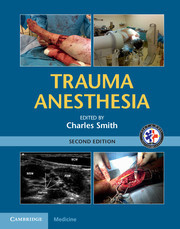Description
Trauma Anesthesia (2nd Ed., Revised edition)
Coordinator: Smith Charles E.
Covers a broad spectrum of traumatic injuries and procedures anesthesiologists perform to care for trauma patients perioperatively, surgically, and post-operatively.
Language: English
Subject for Trauma Anesthesia:
Publication date: 04-2015
760 p. · 22.7x28.3 cm · Hardback
760 p. · 22.7x28.3 cm · Hardback
Description
/li>Contents
/li>Biography
/li>
Trauma patients present a unique challenge to anesthesiologists, since they require resource-intensive care, often complicated by pre-existing medical conditions. This fully revised new edition focuses on a broad spectrum of traumatic injuries and the procedures anesthesiologists perform to care for trauma patients perioperatively, surgically, and post-operatively. Special emphasis is given to assessment and treatment of co-existing disease, including surgical management of trauma patients with head, spine, orthopedic, cardiac, and burn injuries. Topics such as training for trauma (including use of simulation) and hypothermia in trauma are also covered. Six brand new chapters address pre-hospital and ED trauma management, imaging in trauma, surgical issues in head trauma and in abdominal trauma, anesthesia for oral and maxillofacial trauma, and prevention of injuries. The text is enhanced with numerous tables and 300 illustrations showcasing techniques of airway management, shock resuscitation, echocardiography and use of ultrasound for the performance of regional anesthesia in trauma.
Foreword Martin Giesecke; Preface; Part I. Initial Management of the Trauma Patient: 1. Mechanisms and demographics Joseph F. Golob, Jr and John J. Como; 2. Trauma in the pre-hospital environment and the emergency department Sandra Werner; 3. Trauma airway management E. Orestes O'Brien and William C. Wilson; 4. Shock management Richard P. Dutton; 5. Establishing vascular access in the trauma patient Matthew A. Joy, Donn Marciniak and Kasia Petelenz Rubin; 6. Massive blood transfusion in trauma care Joshua M. Tobin; 7. Blood loss: does it change my intravenous anesthetic? Ken Johnson and Talmage D. Egan; 8. Fluid and blood therapy in trauma Maxim Novikov and Charles E. Smith; Part II. Techniques for Monitoring, Imaging, and Pain Relief: 9. Monitoring the trauma patient Elizabeth A. Steele, P. David Soran, Donn Marciniak and Charles E. Smith; 10. Use of echocardiography and ultrasound in trauma Colin Royse and Alistair Royse; 11. Imaging in trauma Claire Sandstrom; 12. Ultrasound procedures in trauma Paul Soeding and Peter Hebbard; 13. Pharmacology of neuromuscular blocking agents and their reversal in trauma patients François Donati; 14. Hypothermia in trauma Eldar Søreide, Kristian Strand and Charles E. Smith; 15. Pharmacologic management of acute pain in trauma Shalini Dhir, Rakesh Sondekoppam V and Sugantha Ganapathy; 16. Regional anesthesia Shalini Dhir, Ranjita Sharma and Sugantha Ganapathy; 17. Posttrauma chronic pain David Ryan, Yashar Eshraghi and Kutaiba Tabbaa; 18. Damage control in severe trauma Michael J. A. Parr and Ulrike Buehner; 19. Mechanical ventilation of the patient following traumatic injury Roman Dudaryk, Earl Willis Weyers and Maureen McCunn; Part III. Anesthetic Considerations: 20. Head trauma: surgical issues Shoji Yokobori, Khadil Hosein and M. Ross Bullock; 21. Head trauma: anesthetic considerations and management Armagan Dagal and Arthur M. Lam; 22. Surgical considerations for spinal cord trauma Cynthia Nguyen and Timothy Moore; 23. Anesthesia for spinal cord trauma Armagan Dagal and Arthur M. Lam; 24. Oral and maxillofacial trauma: surgical considerations Marcello Guglielmi, Rishad Shaikh, Ketan P. Parekh and Cecil S. Ash; 25. Anesthesia for oral and maxillofacial trauma Olga Kaslow and Elena J. Holak; 26. Eye trauma and anesthesia Martin Dauber and Steven Roth; 27. Musculoskeletal trauma Heather A. Vallier; 28. Anesthesia considerations for musculoskeletal trauma Jeff Gadsden; 29. Cardiac and great vessel trauma Leonardo Canale, Inderjit Gill and Christopher Smith; 30. Anesthesia considerations for cardiothoracic trauma Mark A. Gerhardt and Glenn P. Gravlee; 31. Abdominal trauma: surgical considerations Jeffrey A. Claridge and Jana Hambley; 32. Anesthetic considerations for abdominal trauma Henry G. Chou and William C. Wilson; 33. Intraoperative one-lung ventilation for trauma anesthesia George W. Kanellakos and Peter Slinger; Part IV. Special Populations: 34. Pediatric trauma and anesthesia M. Jocelyn Loy; 35. Intensive care unit management of pediatric brain injury Maroun J. Mhanna, Elie Rizkala and Dennis M. Super; 36. Trauma in the elderly Jeffrey H. Silverstein; 37. Trauma in pregnancy John R. Fisgus, Kalpana Tyagaraj and Vanetta Levesque; 38. Field anesthesia and military injury Nicholas T. Tarmey, Claire L. Park, Craig C. McFarland and Peter F. Mahoney; 39. Burn injuries (critical care in severe burn injury) Charles J. Yowler; 40. Anesthesia for burns Jessica Anne Lovich-Sapola; Part V. Organization of Trauma Management: 41. Prevention of injuries James S. Davis and Carl I. Schulman; 42. Trauma systems, triage, and transfer John J. Como; 43. Teams, team training, and the role of simulation in trauma training and management Paul Barach; Index.
Charles E. Smith is Professor of Anesthesia and the Director of Cardiothoracic and Trauma Anesthesia at MetroHealth Medical Center and Case Western Reserve University School of Medicine, Cleveland, Ohio, USA.
© 2024 LAVOISIER S.A.S.
These books may interest you

Essentials of Trauma Anesthesia 76.41 €



